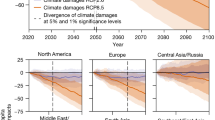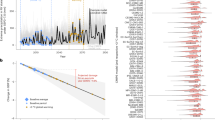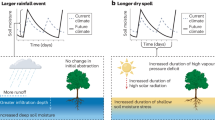Abstract
Nitrous oxide (N2O) is an important anthropogenic greenhouse gas and agriculture represents its largest source. It is at the heart of debates over the efficacy of biofuels, the climate-forcing impact of population growth, and the extent to which mitigation of non-CO2 emissions can help avoid dangerous climate change. Here we examine some of the major debates surrounding estimation of agricultural N2O sources, and the challenges of projecting and mitigating emissions in coming decades. We find that current flux estimates — using either top-down or bottom-up methods — are reasonably consistent at the global scale, but that a dearth of direct measurements in some areas makes national and sub-national estimates highly uncertain. We also highlight key uncertainties in projected emissions and demonstrate the potential for dietary choice and supply-chain mitigation.
This is a preview of subscription content, access via your institution
Access options
Subscribe to this journal
Receive 12 print issues and online access
$209.00 per year
only $17.42 per issue
Buy this article
- Purchase on Springer Link
- Instant access to full article PDF
Prices may be subject to local taxes which are calculated during checkout



Similar content being viewed by others
References
Van Vuuren, D. P., Weyant, J. & de la Chesnaye, F. Multi-gas scenarios to stabilize radiative forcing. Energy Econ. 28, 102–120 (2006).
van Beek, C. L., Meerburg, B. G., Schils, R. L. M., Verhagen, J. & Kuikman, P. J. Feeding the world's increasing population while limiting climate change impacts: linking N2O and CH4 emissions from agriculture to population growth. Environ. Sci. Policy 13, 289–96 (2010).
Forester, P. et al. in IPCC Climate Change 2007: The Physical Science Basis (eds Solomon, S. et al.) 130–234 (Cambridge Univ. Press, 2007).
Galloway, J. N. et al. Nitrogen cycles: past, present, and future. Biogeochemistry 70, 153–226 (2004).
Mosier, A. et al. Closing the global N2O budget: nitrous oxide emissions through the agricultural nitrogen cycle – OECD/IPCC/IEA phase II development of IPCC guidelines for national greenhouse gas inventory methodology. Nutr. Cycl. Agroecosys. 52, 225–248 (1998).
Syakila, A. & Kroeze, C. The global nitrous oxide budget revisited. Greenhouse Gas Measure. Manage. 1, 17–26 (2011).
Mosier, A. & Kroeze, C. Potential impact on the global atmospheric N2O budget of the increased nitrogen input required to meet future global food demands. Chemosphere 2, 465–473 (2000).
Galloway, J. N. et al. Transformation of the nitrogen cycle: Recent trends, questions, and potential solutions. Science 320, 889–892 (2008).
Davidson, E. A. The contribution of manure and fertilizer nitrogen to atmospheric nitrous oxide since 1860. Nature Geosci. 2, 659–662 (2009).
US EPA Global Anthropogenic Non-CO2 Greenhouse Gas Emissions 1990–2030 [draft] (US Environmental Protection Agency, 2011).
Denman, K. L. et al. in IPCC Climate Change 2007: The Physical Science Basis (eds Solomon, S. et al.) 499–587 (Cambridge Univ. Press, 2007).
Hutchinson, G. L. & Mosier, A. R. Improved soil cover method for field measurement of nitrous oxide fluxes. Soil Sci. Soc. Am. J. 45, 311–316 (1981).
Smith, K. A. et al. The measurement of nitrous oxide emissions from soil by using chambers. Phil. Trans. R. Soc. Lond. A 351, 327–338 (1995).
Mosier, A. R., Duxbury, J. M., Freney, J. R. & Heinemeyer, O. Nitrous oxide emissions from agricultural fields: Assessment, measurement and mitigation. Plant Soil 181, 95–108 (1996).
Stevens, R. J. & Laughlin, R. J. Measurement of nitrous oxide and di-nitrogen emissions from agricultural soils. Nutr. Cycl. Agroecosys. 52, 131–13 (1998).
Crutzen, P. J., Mosier, A. R., Smith, K. A. & Winiwarter, W. N2O release from agro-biofuel production negates global warming reduction by replacing fossil fuels. Atmos. Chem. Phys 8, 389–395 (2008).
Del Grosso, S. J., Wirth, T., Ogle, S. M. & Parton, W. J. Estimating agricultural nitrous oxide emissions. Trans. Am. Geophys. Union 89, 529–540 (2008).
Nevison, C. & Holland, E. A re-examination of the impact of anthropogenically fixed nitrogen on atmospheric N2O and the stratospheric O3 layer. J. Geophys. Res. 102, 25519–25536 (1997).
Galloway, J. N. et al. The nitrogen cascade. Bioscience 53, 341–356 (2003).
Smith, K. A., Mosier, A. R., Crutzen, P. J. & Winiwarter, W. The role of N2O derived from biofuels, and from agriculture in general, in Earth's climate. Phil. Trans. R. Soc. B 367, 1169–1174 (2012).
Freibauer, A. Regionalised inventory of biogenic greenhouse gas emissions from European agriculture. Eur. J. Agron. 19, 135–160 (2003).
IPCC Guidelines for National Greenhouse Gas Inventories Vol. 4 (eds Eggleston, H. S., Buendia, L., Miwa, K., Ngara, T. & Tanabe, K.) Ch. 11 (IGES, 2006).
Sawamoto, T., Nakajima, Y., Kasuya, M., Tsuruta, H. & Yagi, K. Evaluation of emission factors for indirect N2O emission due to nitrogen leaching in agro-ecosystems. Geophys. Res. Lett. 32, L03403 (2005).
Reay, D. S., Smith, K. A. & Edwards, A. C. Nitrous oxide in agricultural drainage waters. Glob. Change Biol. 9, 195–203 (2003).
Smith, P. et al. Policy and technological constraints to implementation of greenhouse gas mitigation options in agriculture. Agric. Ecosyst. Environ. 118, 6–28 (2007).
Bryan, E., Akpalu, W., Yesuf, M. & Ringler, C. Global carbon markets: Opportunities for sub-Saharan Africa in the agriculture and forestry. Clim. Dev. 2, 309–331 (2010).
US Census Bureau Total Mid-Year Population for the World 1950–2050; available at http://www.census.gov/population/international/data/idb/worldpoptotal.php
UN FAO World Agriculture: Towards 2030/50 (Interim Report. Food and Agriculture Organization of the United Nations, 2006).
OECD and UN FAO Agricultural Outlook 2011–2020 (Organisation for Economic Co-operation and Development and Food and Agriculture Organization of the United Nations); available at http://stats.oecd.org/
Popp, A., Lotze-Campen, H. & Bodirsky, B. Food consumption, diet shifts and associated non-CO2 greenhouse gases from agricultural production. Glob. Environ. Change 20, 451–462 (2010).
Smith, P. et al. in IPCC Climate Change 2007: Mitigation (eds Metz, B., Davidson, O. R., Bosch, P. R., Dave, R. & Meyer, L. A.) Ch. 8 (Cambridge Univ. Press, 2007).
Fargione, J. et al. Land clearing and the biofuel carbon debt. Science 319, 1235–1237 (2008).
Searchinger, T. et al. Use of US land for biofuels increases greenhouse gases through emissions from land-use. Change. Science 319, 1238–1240 (2008).
Wise, M. et al. Implications of limiting CO2 concentrations for land use and energy. Science 324, 1183–1186 (2009).
Erisman, J. W., van Grinsven, H., Leip, A., Mosier, A. & Bleeker, A. Nitrogen and biofuels; an overview of the current state of knowledge. Nutr. Cycl. Agroecosys. 86, 211–223 (2010).
Melillo, J. M. et al. Indirect emissions from biofuels: How important? Science 326, 1397–1399 (2009).
Robertson, P. G. et al. Sustainable biofuels redux. Science 322, 49–50 (2008).
Reay, D. S., Dentener, F., Smith, P., Grace, J. & Feely, R. Global nitrogen deposition and carbon sinks. Nature Geosci. 1, 430–437 (2008).
Firestone, M. K. et al. in Exchange of Trace Gases Between Terrestrial Ecosystems and the Atmosphere (eds Andreae, M. O., Schimel, D. S. & Robertson, G. P.) 7–21 (Wiley, 1989).
Conen, F. & Neftel, A. Do increasingly depleted δ15N values of atmospheric N2O indicate a decline in soil N2O reduction? Biogeochem. 82, 321–326 (2007).
Ullah, S. & Zinati, G. M. Denitrification and nitrous oxide emissions from riparian forests soils exposed to prolonged nitrogen runoff. Biogeochem. 81, 253–267 (2006).
Mosier, A. R. Nitrous oxide from agricultural soils. Fert. Res. 37, 191–200 (1994).
Bremner, J. M. Sources of nitrous oxide in soils. Nutr. Cycl. Agroecosys. 49, 7–16 (1997).
Ambus, P. Nitrous oxide production by denitrification and nitrification in temperate forest, grassland and agricultural soils. Eur. J. Soil Sci. 49, 495–502 (1998).
Singh, B. K. Bardgett, R. D., Smith, P. & Reay, D. S. Microorganisms and climate change: terrestrial feedbacks and mitigation options. Nature Rev. Microbiol. 8, 779–790 (2010).
Butterbach-Bahl, K. & Dannenmann, M. Denitrification and associated soil N2O emissions due to agricultural activities in a changing climate. Curr. Opin. Environ. Sustain. 3, 389–395 (2011).
Eckard, R. J. & Cullen, B. R. Impacts of future climate scenarios on nitrous oxide emissions from pasture based dairy systems in south eastern Australia. Animal Feed Sci. Technol. 166–167, 736–748 (2011).
Van Groeningen, K. J., Osenberg, C. W. & Hungate, B. A. Increased soil emissions of potent greenhouse gases under increased atmospheric CO2 . Nature 475, 214–216 (2011).
Abdalla, M. et al. Testing DAYCENT and DNDC model simulations of N2O fluxes and assessing the impacts of climate change on the gas flux and biomass production from a humid pasture. Atmos. Environ. 44, 2961–2970 (2010).
Kamp, T., Steindl, H., Hantschel, R. E., Beese, F. & Munch, J. C. Nitrous oxide emissions from a fallow and wheat field as affected by increased soil temperatures. Biol. Fert. Soils 27, 302–314 (1998).
Cantarel, A. A. M., Bloor, J. M. G., Deltroy, N & Soussana, J-F. Effects of climate change drivers on nitrous oxide fluxes in an upland temperate grassland. Ecosystems 14, 223–233 (2011).
Parry, M. L., Rosenzweig, C., Iglesias, A., Livermore, M. & Fischer, G. Effects of climate change on global food production under SRES emissions and socio-economic scenarios. Global Environ. Change A 14, 53–67 (2004).
Oleson, J. E. et al. Uncertainties in projected impacts of climate change on European agriculture and terrestrial ecosystems based on scenarios from regional climate models. Climatic Change 81, 123–143 (2007).
Sommer, S. G. et al. Processes controlling ammonia emission from livestock slurry in the field. Eur. J. Agron. 19, 465–486 (2003).
Mkhabela, M. S., Gordon, R., Burton, D., Smith, E. & Madani, A. The impact of management practices and meteorological conditions on ammonia and nitrous oxide emissions following application of hog slurry to forage grass in Nova Scotia. Agr. Ecosyst. Environ. 130, 41–49 (2009).
UNEP and WHRC Reactive Nitrogen in the Environment: Too Much or Too Little of a Good Thing (United Nations Environment Programme, 2007).
Tilman, D., Cassman, G. K., Matson, P. A., Naylor, R. & Polasky, S. Agricultural sustainability and intensive production practices. Nature 418, 671–677 (2002).
Balasubramanian, V. et al. in Agriculture and the Nitrogen Cycle: Assessing the Impacts Of Fertilizer use on Food Production and the Environment (eds Mosier, A. R., Syers, J. K. & Freney, J. R.) 19–43 (Scientific Committee on Problems of the Environment series vol. 65, Island Press, 2004).
Dobermann, A. in Fertilizer Best Management Practices: General Principles, Strategy for their Adoption and Voluntary Initiatives vs Regulations 1–28 (International Fertilizer Industry Association, 2007).
IFA Sustainable Management of the Nitrogen Cycle in Agriculture and Mitigation of Reactive Nitrogen Side Effects (International Fertilizer Industry Association, 2007).
US-EPA Global Mitigation of Non-CO2 Greenhouse Gases (United States Environmental Protection Agency, 2006).
Smith, P. et al. Greenhouse gas mitigation in agriculture. Phil. Trans. R. Soc. B 363, 789–813 (2008).
Chen, Q. et al. Evaluation of current fertilizer practice and soil fertility in vegetable production in the Beijing region. Nutr. Cycl. Agroecosyst. 69, 51–58 (2004).
Garg, A., Shukla, P. R., Kapshe, M. & Manon, D. Indian methane and nitrous oxide emissions and mitigation flexibility. Atmos. Environ. 38, 1965–1977 (2004).
Flynn, H. C. & Smith, P. Greenhouse Gas Budgets of Crop Production – Current and likely Future Trends First edn (IFA, 2010).
Smil, V. Enriching the Earth: Fritz Haber, Carl Bosch and the Transformation of World Food Production (MIT Press, 2001).
Erisman, J. W., Sutton, M. A., Galloway, J., Klimont, Z. & Winiwarter, W. How a century of ammonia synthesis changed the world. Nature Geosci. 1, 636–639 (2008).
Johnson, J. M.-F., Franzluebbers, A. J., Lachnicht Weyers, S. & Reicosky, D. C. Agricultural opportunities to mitigate greenhouse gas emissions. Environ. Pollut. 150, 107–204 (2007).
Snyder, C. S., Bruulsema, T. W., Jensen, T. L. & Fixen, P. E. Review of greenhouse gas emissions from crop production systems and fertilizer management effects. Agr. Ecosyst. Environ. 133, 247–266 (2009).
Del Grosso, S. J. & Grant, D. W. Reducing agricultural GHG emissions: role of biotechnology, organic systems and consumer behaviour. Carbon Manag. 2, 505–508 (2011).
Vergé, X. P. C., De Kimpe, C. & Desjardins, R. L. Agricultural production, greenhouse gas emissions and mitigation potential. Agr. Forest Meteorol. 142, 255–269 (2007).
Sanchez, P. A. Soil fertility and hunger in Africa. Science 295, 2019–2020 (2002).
Winiwater, W. et al. in European Nitrogen Assessment: Sources, Effects and Policy Perspectives (eds Sutton, M. A. et al.) Ch. 24, 551–569 (Cambridge Univ. Press, 2011).
Stehfest, E. et al. Climate benefits of changing diet. Climatic Change 95, 83–102 (2009).
McMichael, A. J., Powles, J. W., Butler, C. D. & Uauy, R. Food, livestock production, energy, climate change, and health. Lancet 370, 1253–1263 (2007).
Edwards, P. & Roberts, I. Population adiposity and climate change. Int. J. Epidemiol. 38, 1137–1140 (2009).
Williams, A. G., Audsley, E. & Sandars, D. L. Determining the Environmental Burdens and Resource use in the Production of Agricultural and Horticultural Commodities (Cranfield University and Defra, UK, 2006).
UN FAO The State of World Fisheries and Aquaculture, 2008 (Food and Agriculture Organization of the United Nations, 2009).
Williams J. & Crutzen P. J. Nitrous oxide from aquaculture. Nature Geosci. 3, 143 (2010).
UN FAO Global Food Losses and Waste (Food and Agriculture Organization of the United Nations, 2011).
WRAP Household food and drink waste in the UK (Waste & Resources Action Programme, UK, 2009).
Foley, J. A. et al. Solutions for a cultivated planet. Nature 478, 337–342 (2011).
Author information
Authors and Affiliations
Contributions
D.S.R. conceived the Review, conducted the analyses of diet and food waste impacts, and prepared the manuscript. All authors contributed in the writing and editing of the manuscript.
Corresponding author
Ethics declarations
Competing interests
The authors declare no competing financial interests.
Supplementary information
Supplementary Information
Global agriculture and nitrous oxide emissions (PDF 325 kb)
Rights and permissions
About this article
Cite this article
Reay, D., Davidson, E., Smith, K. et al. Global agriculture and nitrous oxide emissions. Nature Clim Change 2, 410–416 (2012). https://doi.org/10.1038/nclimate1458
Published:
Issue Date:
DOI: https://doi.org/10.1038/nclimate1458
This article is cited by
-
Economy-wide impact of climate smart agriculture in India: a SAM framework
Journal of Economic Structures (2024)
-
Waste milk humification product can be used as a slow release nano-fertilizer
Nature Communications (2024)
-
Spent mushroom substrate as a substitute for chemical fertilizer changes N-cycling genes and reduces N2O emission in different textured soils
Biology and Fertility of Soils (2024)
-
Responses of the fungal-bacterial community and network to surface mulching and nitrogen fertilization in the Loess Plateau
Plant and Soil (2024)
-
Integrative meta-omics in Galaxy and beyond
Environmental Microbiome (2023)





